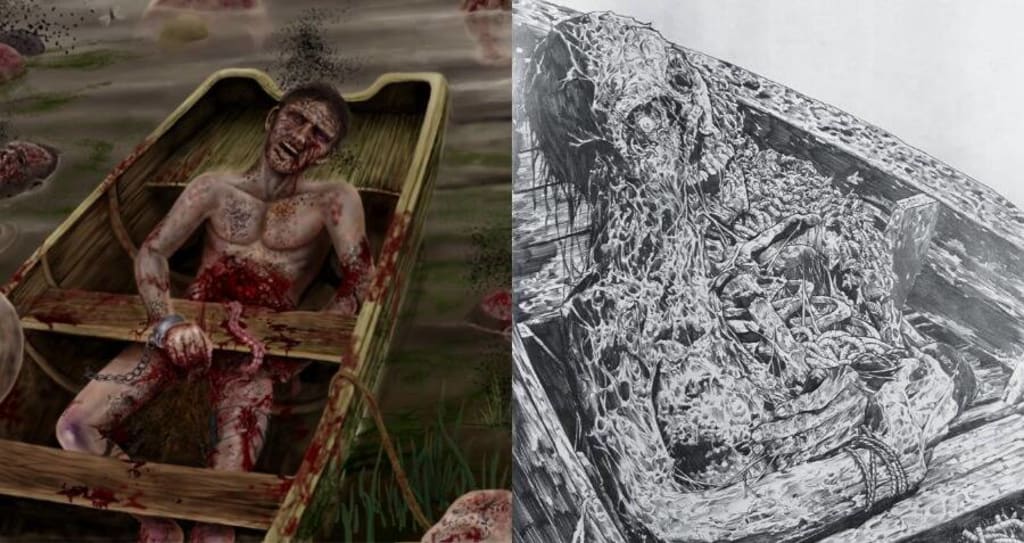Content warning
This story may contain sensitive material or discuss topics that some readers may find distressing. Reader discretion is advised. The views and opinions expressed in this story are those of the author and do not necessarily reflect the official policy or position of Vocal.
Scaphism: The Horrors of Ancient Torture and Execution
Terrible Torture

The history of human civilization is dotted with instances of extreme cruelty, often manifesting in the methods devised for punishment and execution. Among the most horrifying and grotesque of these methods is scaphism, also known as "the boats." This ancient Persian torture technique, later adopted by the Greeks, stands as a chilling testament to the depths of human cruelty. Scaphism involved trapping a person between two boats or hollowed-out tree trunks, smearing them with honey and milk, and then leaving them to be slowly devoured by insects. This blog post delves into the gruesome details of scaphism, exploring its origins, methodology, and the macabre fascination it holds in historical discourse.
Origins and Historical Context
Scaphism, derived from the Greek word "skaphe," meaning "anything scooped (or hollowed) out," finds its origins in ancient Persia. The method is most famously recorded by Greek historian Plutarch in his work "Life of Artaxerxes." According to Plutarch, scaphism was employed as a punishment for high treason, notably in the case of Mithridates, who was condemned for the murder of Artaxerxes II’s brother, Cyrus the Younger.
The Persian Empire, known for its sophisticated administrative and military systems, paradoxically also developed some of the most barbaric methods of punishment. Scaphism was not just a means of execution but a method designed to instill terror. It served as a stark warning to potential traitors and criminals about the severe consequences of their actions.
The Methodology of Scaphism
The process of scaphism was meticulously cruel. The condemned individual was stripped naked and securely fastened between two boats or within a hollowed-out tree trunk, with their head, hands, and feet protruding. This confinement rendered the victim immobile, leaving them at the mercy of the elements and other external forces.
The next step involved force-feeding the victim with a mixture of milk and honey until they were thoroughly engorged. This concoction served two purposes: it induced severe diarrhea, causing the person to defecate within the confined space, and it smeared the body, attracting a myriad of insects. The victim’s exposed skin was also coated with the same mixture, further enticing insects and vermin.
The true horror of scaphism lay in its slow, excruciating progression. The victim, immobilized and smeared with honey and milk, became a living feast for insects. Flies, ants, and other scavengers would be drawn to the sticky sweetness, laying eggs and feeding on the person’s flesh. The initial stages would see the victim covered in swarms of flies, which would begin to lay eggs in the exposed and increasingly infected wounds.
As days passed, the individual would suffer from extreme dehydration, sun exposure, and the agony of being eaten alive by insects and larvae. The continuous consumption of milk and honey, often forcefully administered, would keep the person alive longer than they might otherwise survive, prolonging the torture. Death would eventually come, but not before the victim had endured unimaginable suffering from infection, exposure, and the unrelenting assault of insects.
Psychological and Social Impact
Scaphism was not merely a form of execution; it was a psychological weapon. The sheer horror of the method served to instill fear among the populace. By making an example of those who committed serious offenses, the ruling authorities aimed to deter others from similar acts. The public nature of these executions, often carried out in visible locations, ensured that the gruesome spectacle would be witnessed by many, spreading the message of the state’s power and the dire consequences of defying it.
This method of execution also reflects the complex nature of ancient justice systems. While many ancient civilizations developed sophisticated legal frameworks, the implementation of justice could be extraordinarily brutal. Scaphism exemplifies how punishment was designed not only to eliminate the offender but also to serve as a potent reminder of the state’s authority and the severe repercussions of disobedience.
The Legacy of Scaphism
The legacy of scaphism endures as a grim reminder of the extremes to which human beings can go in inflicting pain and asserting control. It occupies a dark place in the annals of history, alongside other brutal methods of execution such as crucifixion, impalement, and burning at the stake.
In modern times, the tale of scaphism serves as a reflection on the evolution of justice and human rights. It stands in stark contrast to contemporary views on punishment, which increasingly emphasize rehabilitation over retribution and humane treatment over cruelty. The horror of scaphism underscores the importance of human rights advancements and the ongoing struggle to eliminate torture and inhumane treatment worldwide.
Conclusion
Scaphism, with its horrifying blend of psychological torment and physical agony, represents one of the darkest chapters in the history of punishment and execution. This ancient method, designed to maximize suffering and instill fear, highlights the extreme measures employed by ancient civilizations to maintain control and enforce justice. Today, the story of scaphism serves as a powerful reminder of the importance of upholding human dignity and the continuous effort to ensure that such barbarity remains confined to the past.
About the Creator
Enjoyed the story? Support the Creator.
Subscribe for free to receive all their stories in your feed. You could also pledge your support or give them a one-off tip, letting them know you appreciate their work.






Comments
There are no comments for this story
Be the first to respond and start the conversation.